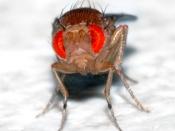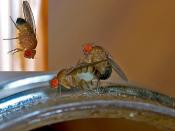The Genetics of Drosophila Fruit FliesIntroductionThe Drosophila Melanogaster, typically known as the fruit fly, is a widespread species used in genetic laboratory studies. Using fruit flies have many advantages for this type of study. Drosophila fruit fly lays hundreds of eggs after just one mating, and has a generation time of two weeks. The fruit flies also mature quickly and don't require too much space. The life cycle of fruit flies has several specific stages. The first stage continues for about 24 hours, the embryo forms in an egg and develops into larva. In the next stage, the larva changes into the instar larva. After three or four days later, the larva alters forming a pupa. The fruit fly stays in the pupa for approximately six days. At this stage, adult characteristics develop. When the fruit fly hatches from the pupa, it's considered to be fully matured. After about 15 hours, fruit fly achieves reproductive features; females will begin lay eggs, and the whole cycle starts over again.
The main purpose of this experiment was to determine and examine the phenotype after crossing fruit flies; to determine how many offspring will have red eyes, white eyes, tan body color, and black body color. The hypothesis of this experiment was that the red eyed flies will have dominance over the white eyed flies.
MethodsThe hypothesis was tested at the Adams State College in the Cell Biology/Genetics laboratory room. The overall study took three month. The experiment was begun by preparing the small test tubes. The students placed sand and wet strip of paper into each test tube. There were 20 test tubes; 10 for white male flies and 10 for black female flies. The moist strip of paper was required to make sure that the hatched fly from the pupa...


